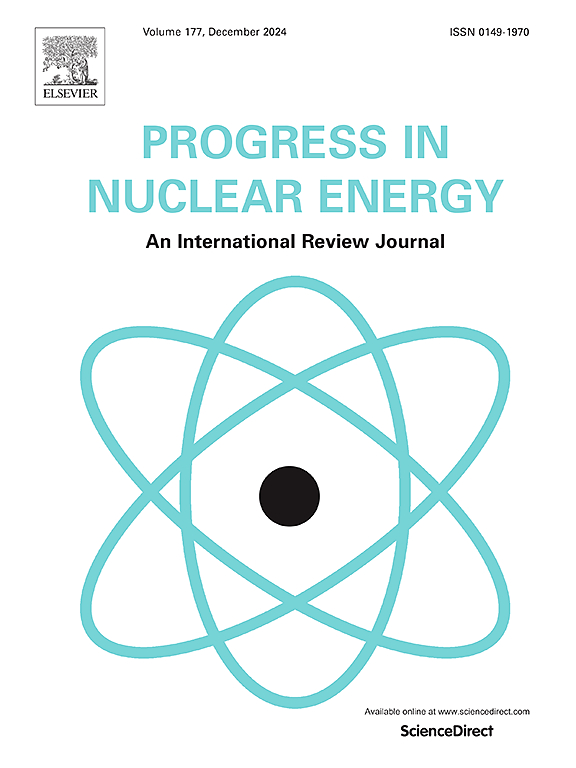The flow and heat transfer in the rod bundle channel in the natural circulation system for heaving and rolling conditions
IF 3.3
3区 工程技术
Q1 NUCLEAR SCIENCE & TECHNOLOGY
引用次数: 0
Abstract
Floating nuclear power plants are continually exposed to sea waves, which leads to rolling and heaving movement of the fuel assembly in the nuclear reactor. The majority of heat transfer experiments were carried out at low pressure, which is far from the operating pressure of nuclear power plants. Moreover, the effects of heaving on thermal hydraulics characteristics were barely experimentally investigated. The impact of heaving and rolling on the mass flux, flow resistance, rod wall temperatures and heat transfer coefficients (HTCs) of single-phase flow in a 3 × 3 rod bundle in a natural circulation loop are acquired experimentally in this research. The experimental findings suggest that the mass flux variation plot is very close to a sinusoidal curve pattern during heaving process. Rolling amplitude has a large effect on the average mass flux and fluctuation amplitudes of mass flux. In the cases where the rolling amplitude reaches a rather large angle, the average mass flux throughout rolling operation descends. The transient wall temperatures and HTCs did not change much during the heaving process, while the fluctuations of HTCs and rod wall temperatures are more drastic in rolling process. As the rolling amplitude reaches 30°, it can be clearly observed that the average HTC throughout the entire rolling operation exceeds the steady state HTC before rolling. The fluctuation of Re in the heaving process is not the main factor of the HTC fluctuation. Instead, the key factor contributing to the HTC fluctuation is the crossflow within the sub-channels.
起伏和滚动条件下自然循环系统中棒束通道的流动和传热
浮动核电站持续暴露在海浪中,导致核反应堆中燃料组件的滚动和起伏运动。大多数换热实验都是在低压下进行的,与核电站的运行压力相差甚远。此外,升沉对热工特性的影响几乎没有实验研究。实验研究了自然循环回路中3 × 3棒束中起伏和滚动对单相流质量通量、流动阻力、杆壁温度和换热系数的影响。实验结果表明,在起伏过程中,质量通量变化图非常接近正弦曲线模式。滚动幅值对平均质量通量和质量通量波动幅值影响较大。当轧制幅值达到较大角度时,整个轧制过程的平均质量通量下降。在胀胀过程中,瞬态壁温和高温混凝土的变化不大,而在轧制过程中,高温混凝土和棒壁温度的波动更为剧烈。当滚动幅值达到30°时,可以清楚地观察到整个滚动过程中的平均HTC超过了滚动前的稳态HTC。起伏过程中Re的波动不是影响HTC波动的主要因素。相反,导致HTC波动的关键因素是子通道内的交叉流动。
本文章由计算机程序翻译,如有差异,请以英文原文为准。
求助全文
约1分钟内获得全文
求助全文
来源期刊

Progress in Nuclear Energy
工程技术-核科学技术
CiteScore
5.30
自引率
14.80%
发文量
331
审稿时长
3.5 months
期刊介绍:
Progress in Nuclear Energy is an international review journal covering all aspects of nuclear science and engineering. In keeping with the maturity of nuclear power, articles on safety, siting and environmental problems are encouraged, as are those associated with economics and fuel management. However, basic physics and engineering will remain an important aspect of the editorial policy. Articles published are either of a review nature or present new material in more depth. They are aimed at researchers and technically-oriented managers working in the nuclear energy field.
Please note the following:
1) PNE seeks high quality research papers which are medium to long in length. Short research papers should be submitted to the journal Annals in Nuclear Energy.
2) PNE reserves the right to reject papers which are based solely on routine application of computer codes used to produce reactor designs or explain existing reactor phenomena. Such papers, although worthy, are best left as laboratory reports whereas Progress in Nuclear Energy seeks papers of originality, which are archival in nature, in the fields of mathematical and experimental nuclear technology, including fission, fusion (blanket physics, radiation damage), safety, materials aspects, economics, etc.
3) Review papers, which may occasionally be invited, are particularly sought by the journal in these fields.
 求助内容:
求助内容: 应助结果提醒方式:
应助结果提醒方式:


